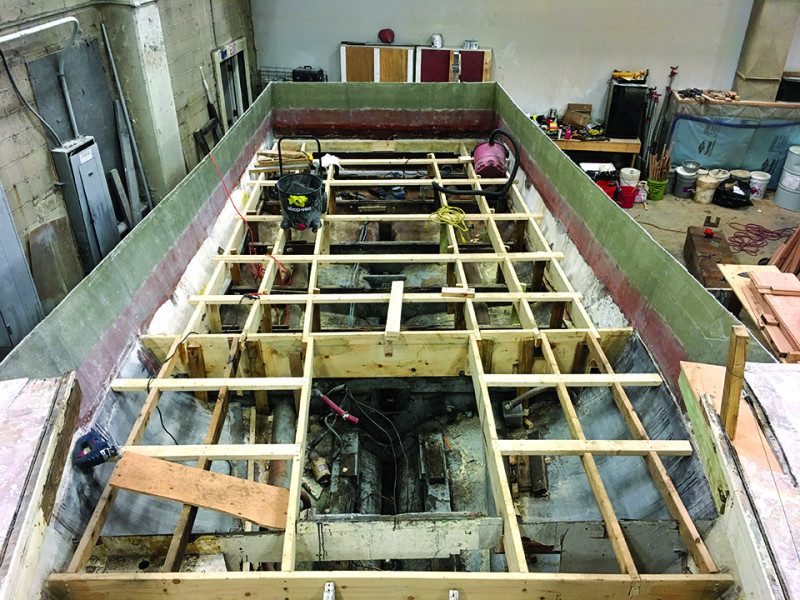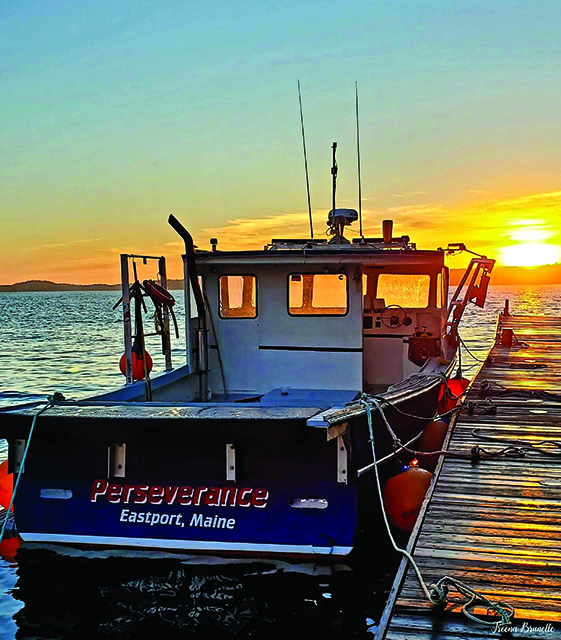With the average age of U.S. fishermen in the 50s and trending upward, young people are the lifeblood of the industry. Programs to support young people in fisheries have been launched and lauded on every coast. But for some young folks it’s hardly necessary. They can’t be stopped. When they look at the harbors and the sea, they see “opportunity” writ large, and they are going for it.
Elijah Brice of Eastport, Maine, is among them. Brice’s family moved to Maine from New Jersey when he was 7 years old, and he took root like a native plant.
At age 15, Brice got his student lobster license and 150 traps. His father helped him buy a 20-foot outboard. “I did about all I could with that boat,” Brice says. “I snapped the davit off twice, one time up in the falls, I was hung down and the tide was running and it was pulling us down. My rope cutter blade broke, I couldn’t get to my other knife, and then the davit just snapped. I said, you can have it. I was lucky.” A teenager pushing the limits with a 20-foot outboard in an area with 27-foot tides has to be lucky, the reversing falls of Cobscook Bay have eaten bigger boats than his.
Now with 400 traps and gaining 100 every year, Brice has realized he needs to grow his boat if he wants to carry on in the fishery. “Butch Harris had this hull, and I bought it off him. It was built by a guy named Dana Hunter in Tatamagouche, in Nova Scotia. I’m not sure when.”
Like Brice, Butch Harris grew up working on the water and has owned a number of boats, including the hulk he sold to Brice. “It was a tour boat over on Campobello,” Harris says of the 32-foot fiberglass Novi hull. “They let it go. The engine was not good. Elijah took it down to nothing but the hull.”

Originally the Miss Kim, Brice renamed the boat as Perseverance, and rightly so. In December 2019, he moved the hull into a shop Harris owns. But before he could begin working, he had to have hernia surgery. “I started on March 1st,” he says. “I took off the old cabin, and the old deck. They had a 14-inch step up into the cabin! And the cabin trunk was so high, I couldn’t really see from the wheelhouse, so I took that off, too.”
Brice stripped the vessel down to virtually nothing but the skin of the hull, as it was when it came out of the mold. Then Brice had to design the boat he wanted, starting with the wheelhouse.
“I went up to Cape Breton Island,” says Brice. “There was a guy there with this same hull and a wheelhouse I liked. So I just measured it and built it.” Brice added some touches of his own. “I added the overhang forward, and I extended the port side wall to give my crew more protection.” Brice also cut away more of the starboard wall to give himself better access to traps coming aboard.
Novi boats are generally easy to spot, with a high plumb bow that drops steeply to a low, slightly sweeping sheer. But having worked in a low-sided outboard for three years, Brice wanted a change. “I followed the sheer line but raised the sides 14 inches,” he says. “And I raised the deck, so it’s all one level and drains out the stern.”
The Perseverance being Brice’s first boat, he did not wing it alone. “I am so lucky to have a wealth of knowledgeable people around,” he says. “I’d get an idea, and I’d bounce it off different people, and they’d help me figure things out.”
Among his mentors, Butch Harris probably spent the most time helping Brice. “I showed him how to fiberglass,” says Harris. “And I helped him figure out how to build up the sides. I didn’t do much really, just tried to answer his questions.”
Brice built up the deck with hot-coated 2 x 6 framing and 3/4 plywood that he finished with 1.5-ounce fiberglass mat, a layer of woven roving, and gelcoat. “Every seam has an excessive amount of gelcoat,” he says. Brice has three 2-foot-square hatch covers to access his reduction gear shaft and stuffing box, one is a Freeman and two are Bomar. “I got them off two different boats,” says Brice. “Those things are expensive. New, they’re like, 2,000 dollars.”
For power, Brice picked up a rebuilt 270-hp Cummins JWAC 6BTA.
“A guy was going to put it in his boat but changed his mind. I got a really good deal on it. It came with the gear, a Twin Disc MG506, with 2:1 reduction.” Brice transfers that power through a 1.5-inch-diameter shaft to a 23-inch square propeller. “It’s got an old-fashioned stuffing box. I want to go to dripless as soon as I can.”
Coming off the front end of the Cummins is Brice’s hydraulic system. “I got the hauler used. It’s 14-inch, and I’m looking forward to that after that 10-inch. Everything else is new, the clutch, the pump, the hoses, valves. The pump is made by Metaris.”
Brice hauls his gear with a Canadian block, which has rounded teeth on the outer flange to help lift the gear. “It came with the boat,” says Brice. “I’ll try it, see if I like it. Breaking those traps in will wear out your rotor cuff. This makes it a little easier.” The block is used, but the davit and other aluminum work on the boat is brand new. “Steve Cox did it all,” says Brice. “He did the davit, the exhaust system, and the prop cage.” Brice also added a 2-foot overhang off the stern to save on deck space. “He did the brackets for that, too.”
The wheelhouse of the Perseverance is equipped with the basics: a new Furuno 1815 radar, a Furuno FCV-628 sounder, and two VHFs. For deck lights and spot lights, Brice has scavenged LCDs from here and there. “I don’t know what brand they are. That middle one came off my truck.”
Brice figures he has about $60,000 into the project, plus his time.
“Price out a 32-footer at H&H, and it’s $150,000. With this I’ve got a boat for half or a third of that, and by working by myself and with other people, I’ve given myself an educational experience. I’m grateful to have so many local people with a vast amount of knowledge.”
Brice figures he has put in an average of 12 hours a day, and local spectators acknowledge that his truck is always there and the lights are always on in the shop.
“Once I started working, I realized what I’d started. It’s a big project compared to what I’ve done before. It’s hard to stay organized, I spend about 20 percent of my time just looking for tools.” Brice can see the light at the end of the tunnel and is eager to get his new boat into the water before the fall run really comes on.
“I’ve got tunnel vision for getting this finished,” he says. But he’s not sure if the Perseverance is a stepping stone, or a boat he will fish for a long time. With so much uncertainty in fisheries, Brice is playing it safe and positioning himself to keep his money in his pocket. “I like fishing, but I don’t know how things are going to go. I may not get a bigger boat, it might not be cost effective.”
On launch day, Brice is focused. “I’m waiting for the survey,” he says. “I want this boat surveyed and insured before it leaves this building.”
On Sept. 15, 2020, Elijah Brice has the Perseverance almost ready. He is busy taking the light stand off the wheelhouse. “I didn’t sleep last night,” he says. “Excited and also wondering what I’ve gotten myself into.”

As high water approaches, Adam Thompson of Addison, Maine, arrives and loads the boat aboard his trailer. At the ramp near the Eastport breakwater, a crowd of well-wishers has gathered, among them Brice’s father, Colie, with his camera ready, and mother, Manuela, with a champagne bottle.
“You must be proud,” someone shouts. “Just a little bit,” Colie says. Many are amazed that a young man only 18 years old has accomplished this.
The boat splashes, but there is a problem with the cooling pump. Elijah gets his new boat to its slip and starts the trouble-shooting that will keep him occupied for the next few weeks. But he is in the water and ready for fall fishing — when the money is made in Maine’s lobster fishery.







